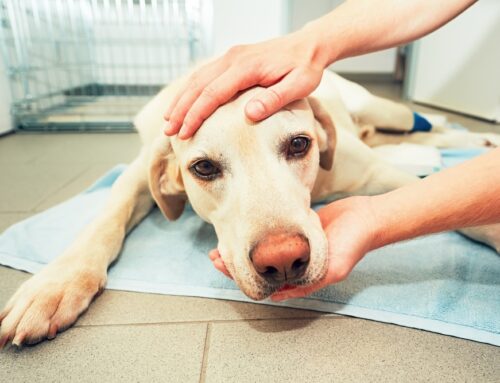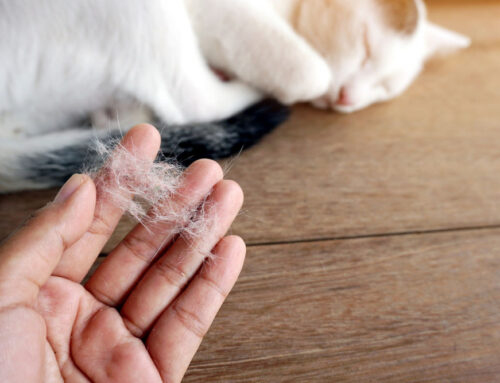Every pet needs to scratch the occasional itch, but constant scratching can signify a serious medical problem. Our Wales Animal Clinic team treats many itchy pets, and we provide information about common causes of pet itchiness and explain how to address these frustrating conditions.
#1: Flea allergy dermatitis causes pet itchiness
Flea allergy dermatitis (FAD) occurs when a pet is allergic to a flea’s saliva. A single flea bite can lead to a severe reaction, and the pet cannot stop constantly scratching, biting, licking, chewing, and rubbing. In many cases, the excessive grooming removes the inciting fleas, making diagnosis difficult. Often, however, the fleas leave behind flea dirt (i.e., excrement) that looks like tiny black specks in your pet’s coat and bedding. If you find flea dirt on an itchy pet, FAD is likely contributing to the problem. Most pets affected by FAD are not only severely itchy, but also have red bumps and hair loss on their lower back, abdomen, and inner thighs.
FAD treatment involves:
- Flea control — Comprehensive, year-round flea prevention is the most important aspect of FAD treatment. Use an appropriate veterinary-approved product, and treat every household pet. In addition, you must eradicate fleas from your pet’s environment, which involves washing bedding, sweeping and vacuuming floors and upholstery, and appropriate insecticide treatment. Fleas have a complicated life cycle, and you must repeat these steps until the fleas have been eradicated at every life stage.
- Bathing — Bathing your pet can help remove fleas and flea dirt and soothe itchy, flea-bitten skin. Wait at least 48 hours after administering your pet’s flea preventive to ensure the product has absorbed properly.
- Medications — We may prescribe medications, such as steroids or other anti-itch drugs, to help alleviate your pet’s itchiness.
#2: Atopy causes pet itchiness

Atopy refers to a reaction to environmental allergens, such as grass and tree pollen, dust mites, and mold spores. Most affected pets start exhibiting signs early in life, typically between 1 and 3 years of age. The condition can affect any area of the pet’s body, but skin lesions and hair loss most commonly occur around the eyes and mouth, and on the feet, abdomen, armpits, groin, and hindquarters. If our team suspects your pet is atopic, we can perform allergy testing, which involves a blood test or intradermal testing to determine the triggering allergens.
Since atopy has no cure, a multi-modal management approach is usually most effective. Strategies include:
- Hyposensitization therapy — Hyposensitization is the gold standard therapy for treating atopy in pets. Therapy involves using the information derived from allergy testing to create allergy shots, which are administered in gradually increasing doses to desensitize your pet to the problematic substance. This treatment helps the majority of pets, but effects can take 6 to 12 months.
- Shampoo — Veterinary-approved shampoos can help remove allergens from your pet’s skin and coat. You should bathe your pet about once a week, and between baths, wipe down their coat with a wet cloth.
- Avoidance — You should try to keep your pet away from the causative allergens. This is not always feasible, but you can reduce their exposure with these tips:
- Dust and vacuum your home often to remove dust mites.
- Keep your doors and windows closed and your air conditioner running as much as possible.
- Keep your pet inside when mowing your lawn.
- Let your pet out only for short bathroom breaks on high allergen days.
- Medications — Steroids and other anti-itch medications are often needed to control an atopic pet’s itchiness.
- Omega-3 fatty acids — Omega-3 fatty acids can help reduce inflammation and itchiness.
#3: Food allergies can cause pet itchiness
A pet who is allergic to ingredients in their food—most commonly proteins such as beef, chicken, dairy, and eggs—can suffer with itchy skin. Most affected pets start exhibiting signs before 6 months of age or over 6 years. Hair loss and skin lesions often occur on a dog’s face, feet, and hindquarters, and on a cat’s head and neck. Some pets may also experience gastrointestinal (GI) signs, including diarrhea, vomiting, and excessive gas. A food allergy can be definitively diagnosed only with a food elimination trial, which involves:
- Finding a hypoallergenic food — You must feed your pet a hypoallergenic food for about eight weeks. You can feed a novel protein, such as venison, bison, duck, or kangaroo, or a hydrolyzed protein diet with protein that is broken down to extremely small components that the body does not recognize.
- Avoiding outside food — During the diet trial, your pet must not eat any other food, including table scraps, medicated chews and supplements, and unsanctioned treats.
- Determining the triggering ingredient — If your pet’s signs improve on the elimination diet, you can challenge them with ingredients from their previous food to determine the triggering ingredient.
- Avoiding the triggering ingredient — Once identified, you must avoid the triggering ingredient.
#4: Skin and ear infections can cause pet itchiness
Many pets affected by allergic conditions also experience chronic and recurrent skin and ear infections that exacerbate their itchiness and complicate diagnosis and treatment. The infections are caused by bacteria and yeast that commonly colonize the skin, but allergies lead to conditions where the organisms can multiply and cause infection. Then, we will take samples to determine the causative pathogen through cytology and culture, and prescribe an appropriate antimicrobial that will resolve the infection.
Pet itchiness is a serious problem that should be addressed as soon as possible. Contact our Wales Animal Clinic team if your pet is itchy, so we can determine the underlying cause and devise an appropriate treatment plan that will alleviate their problem.







Leave A Comment